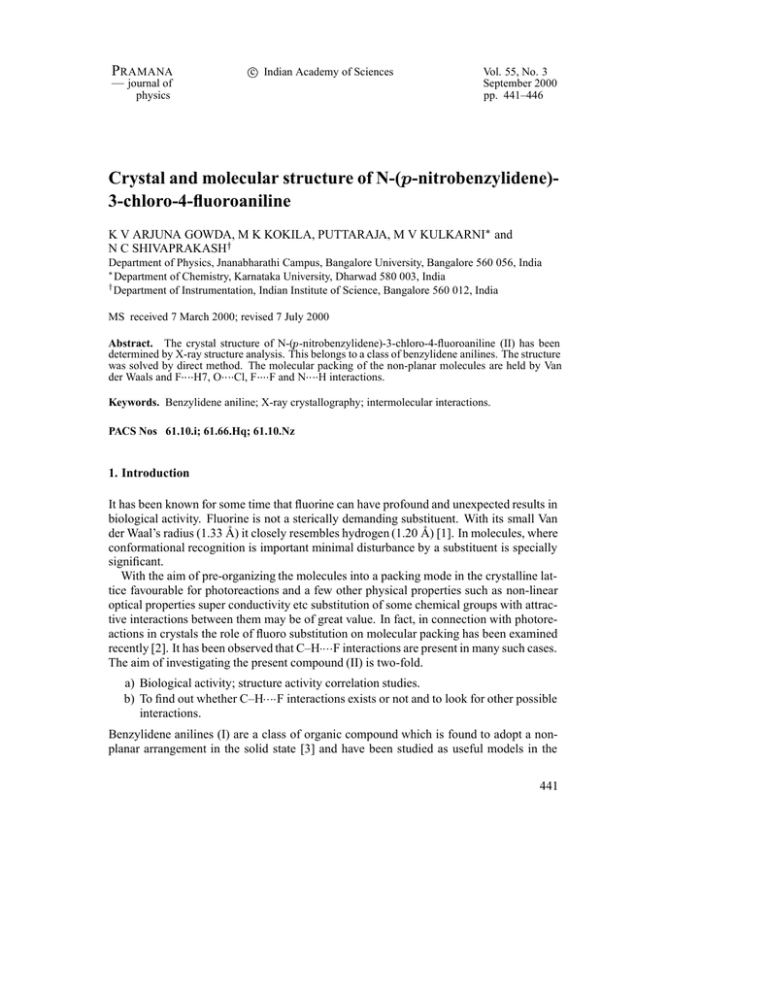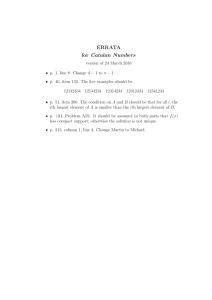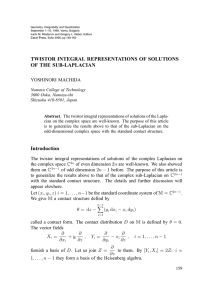Document 13778219
advertisement

c Indian Academy of Sciences PRAMANA — journal of physics Vol. 55, No. 3 September 2000 pp. 441–446 Crystal and molecular structure of N-(p-nitrobenzylidene)3-chloro-4-fluoroaniline K V ARJUNA GOWDA, M K KOKILA, PUTTARAJA, M V KULKARNI and N C SHIVAPRAKASHy Department of Physics, Jnanabharathi Campus, Bangalore University, Bangalore 560 056, India Department of Chemistry, Karnataka University, Dharwad 580 003, India y Department of Instrumentation, Indian Institute of Science, Bangalore 560 012, India MS received 7 March 2000; revised 7 July 2000 Abstract. The crystal structure of N-(p-nitrobenzylidene)-3-chloro-4-fluoroaniline (II) has been determined by X-ray structure analysis. This belongs to a class of benzylidene anilines. The structure was solved by direct method. The molecular packing of the non-planar molecules are held by Van der Waals and F H7, O Cl, F F and N H interactions. Keywords. Benzylidene aniline; X-ray crystallography; intermolecular interactions. PACS Nos 61.10.i; 61.66.Hq; 61.10.Nz 1. Introduction It has been known for some time that fluorine can have profound and unexpected results in biological activity. Fluorine is not a sterically demanding substituent. With its small Van der Waal’s radius (1.33 Å) it closely resembles hydrogen (1.20 Å) [1]. In molecules, where conformational recognition is important minimal disturbance by a substituent is specially significant. With the aim of pre-organizing the molecules into a packing mode in the crystalline lattice favourable for photoreactions and a few other physical properties such as non-linear optical properties super conductivity etc substitution of some chemical groups with attractive interactions between them may be of great value. In fact, in connection with photoreactions in crystals the role of fluoro substitution on molecular packing has been examined recently [2]. It has been observed that C–HF interactions are present in many such cases. The aim of investigating the present compound (II) is two-fold. a) Biological activity; structure activity correlation studies. b) To find out whether C–HF interactions exists or not and to look for other possible interactions. Benzylidene anilines (I) are a class of organic compound which is found to adopt a nonplanar arrangement in the solid state [3] and have been studied as useful models in the 441 K V Arjuna Gowda et al development of the principles of crystal engineering [4]. Introduction of groups like chloro, nitro and dichloro in this class of compounds revealed many interesting features like polymorphism, nature of twist of the two benzene rings and their thermal sensitivity [5]. The fluoro substituent at para-position leads to a change in the mode of packing from to [2]. Introduction of fluoro substituent in a variety of organic compounds has been found to increase crystal densities and enhance the reactivity in solid state photochemical dimerisation [2]. On substitution of fluorine the compound becomes photoreactive in the solid state without changing the mode of packing [6]. 3-chloro-4-fluoroaniline moiety has been found to be the pharmacopnone in a variety of biologically active organofluorine compounds. In view of this, several benzylidene anilines from 3-chloro-4-fluoroanilines have been synthesized as possible anti-inflammatory agents [7]. The role of design element in solid state photochemical reactions has been recently reviewed [8]. Fluorosubstitution on coumarin was used to induce -packing mode which underwent a stereospecific photochemical dimerisation [9]. 2. Experimental Crystals suitable for X-ray diffraction are grown by slow evaporation technique using ethanol. X-ray intensity data are collected on Enraf-Nonius CAD-4 diffractometer with CuK radiation. Three dimensional intensity data were corrected for Lorentz and polarization effects. Absorption and extinction corrections are not applied. The crystallographic data and other details of experimental and refinement are summarized in table 1. The structure was solved by direct method using NRCVAX-crystal structure solution program [10]. The structure thus obtained was refined by using a full-matrix least-squares method to a final value of R = 0:053 on 1344 reflections. 442 Pramana – J. Phys., Vol. 55, No. 3, September 2000 Structure of aniline family Table 1. Crystal data for the title compound. Crystal morphology Crystal size Chemical formula Molecular weight Crystal system Space group Cell constants Yellow needles 0:2 0:2 0:2 mm C13 H8 N2 O2 C1 F 278.66 Monoclinic P21 /c a : Å b : Å c : Å Volume Number of formula units Z Density (calculated) DC Absorption coefficient (CuK ) Unique data measured : (I) Observed data with I F(OOO) R Rw 25 min max = 3 816(2) = 12 669(2) = 24 677(5) = 91:34(3)Æ 3 1192.0(7)Å 4 1.552 gm/cm3 0.33 mm 1 2680 1344 278.67 0.053 0.055 0.280 e/Å3 0.630 e/Å3 3. Results and discussion The fractional co-ordinates and equivalent isotropic temperature factors for non-hydrogen atoms are presented in table 2, and the bond lengths and bond angles are presented in table 3 respectively. The general view of the molecule indicating the numbering scheme is as shown in figure 1. The spatial arrangement of the two benzene rings indicates that the molecules have E -configuration, across the C=N bond. The chloro- and fluoro-substituents attached to the aniline ring have very small deviations of 0.031(8) and 0.021(8) Å. The bond length C3–C1 in aniline ring [1.720(5) Å] is smaller than that observed in N -(pchlorobenzylidene-p-chloroaniline) [11] and the normal C–C1 bond length 1.737 Å was observed in aromatic compounds [12] which may be due to the electron withdrawing pfluoro substituent. The bond lengths, associated with bridging atoms C1, N1, C7 and C1 0 are of significance in reflecting the effect of substituents present in the aniline and benzylidene rings. The electron withdrawing effect of the p-fluoro group has resulted in the lengthening of the C=N bond to 1.256(7) Å when compared to that of the parent benzylidene ring [3] (1.237Å). The C7–C10 bond length 1.463(7) Å is greater than the bond length observed in the p–p dichloro substituted compound 1.437 Å [3]. The bond angle C6–C1–N1=116.1(4) Æ is lesser than that observed in benzylidene aniline (123.7 Æ) [3] indicating that the electron withdrawing nitro group might have a stronger effect on the angle C6–C1–N1, than the Pramana – J. Phys., Vol. 55, No. 3, September 2000 443 K V Arjuna Gowda et al Table 2. Positional coordinates and isotropic temperature factors Uiso (Å2 ) for nonhydrogen atoms with e.s.d’s which are in parentheses. Atom Cl F C3 C4 C5 C6 C1 C2 N1 C7 C10 C20 C30 C40 C50 C60 N2 O1 O2 x y z Uiso 0.0866( 5) 0.0845(10) 0.2116(13) 0.1989(14) 0.3043(16) 0.4205(14) 0.4258(12) 0.3246(14) 0.5462(11) 0.4698(13) 0.5872(12) 0.7450(12) 0.8517(12) 0.7987(12) 0.6430(14) 0.5369(13) 0.9152(11) 0.8221(12) 1.0978(11) 0.4738(14) 0.2515( 3) 0.4219( 5) 0.3148( 5) 0.2706( 5) 0.3359( 4) 0.4438( 4) 0.4872( 5) 0.5035( 3) 0.5996( 4) 0.6656( 4) 0.6206( 4) 0.6826( 4) 0.7901( 4) 0.8375( 4) 0.7741( 4) 0.8576( 4) 0.9495( 3) 0.8190( 3) 0.1771( 6) 0.2065(13) 0.2386(19) 0.2475(22) 0.2953(23) 0.3366(22) 0.3298(19) 0.2799(21) 0.3746(16) 0.3786(20) 0.4238(19) 0.4696(19) 0.5122(19) 0.5087(19) 0.4644(21) 0.4222(21) 0.5535(17) 0.5542(17) 0.5888(16) 0.0623( 8) 0.0678(18) 0.0400(24) 0.0450( 3) 0.0480( 3) 0.0412(23) 0.0339(20) 0.0417(24) 0.0386(19) 0.0366(22) 0.0332(20) 0.0332(20) 0.0338(20) 0.0328(21) 0.0390(23) 0.0393(22) 0.0416(20) 0.0689(23) 0.0594(21) Figure 1. Perspective view of the molecule with atomic numbering scheme. electron donating dimethylamino group. Packing diagram of the molecule viewed along a axis is shown in figure 2. From the packing diagram it is clear that there are at least two types of intermolecular forces that stabilize the crystal structure of this molecule [FH = 2.22 Å]. The fluorine atom of one molecule is at a distance of 2.22 Å from the azomethine hydrogen i.e. H7. Two such interactions are observed in a unit cell. H7 is further in close spatial proximity with the ortho C2 carbon 2.699 Å. The oxygen of the nitro group also show a weak interaction with the p-chloro substituent, one of the oxygens being nearer 3.33 Å than the other 3.40 Å. Similar interaction of nitro group with iodine has already been proposed as a synthon in the crystal engineering of 444 Pramana – J. Phys., Vol. 55, No. 3, September 2000 Structure of aniline family Table 3. Selected bond distances (Å) and bond angles (Æ ). Atom Bond length Cl–C3 F–C4 C3–C4 C3–C2 C4–C5 C5–C6 C5–H5 C6–C1 C6–H6 C1–C2 C1–N1 C2–H2 N1–C7 C7–C10 C1–C3–C4 C1–C3–C2 C4–C3–C2 F–C4–C3 F–C4–C5 C3–C4–C5 C4–C5–C6 C4–C5–H5 C6–C5–H5 C5–C6–C1 C5–C6–H6 C1–C6–H6 C6–C1–C2 C6–C1–N1 C2–C1–N1 C3–C2-C1 C3–C2–H2 C1–C2–H2 C1–N1–C7 N1–C7–C10 N1–C7–H7 C10 –C7–H7 1.720(5) 1.359(6) 1.375(8) 1.379(7) 1.364(8) 1.383(8) 1.030(5) 1.378(7) 0.980(5) 1.401(7) 1.415(6) 0.960(4) 1.256(7) 1.463(7) 120.5(4) 120.4(4) 119.1(5) 118.4(5) 119.6(5) 122.1(5) 118.9(5) 112.3(2) 128.8(2) 120.6(5) 120.0(3) 119.0(3) 119.5(5) 116.1(4) 124.4(5) 119.8(5) 115.0(3) 124.0(3) 120.3(4) 122.9(4) 120.0(3) 116.0(3) Atom C7–H7 C10 –C20 C10 –C60 C20 –C30 C20 –H20 C30 –C40 C30 –H30 C40 –C50 C40 –N2 C50 –C60 C50 –H50 C60 –H60 N2–O1 N2–O2 C7–C10 –C20 C7–C10 –C60 C20 –C10 –C60 C10 –C20 –C30 C10 –C20 –H20 C30 –C20 –H20 C20 –C30 –C40 C20 –C30 –H30 C40 –C30 –H30 C30 –C40 –C50 C30 –C40 –N2 C50 –C40 –N2 C40 –C50 –C60 C40 –C50 –H50 C60 –C50 –H50 C10 –C60 –C50 C10 –C60 –H60 C50 –C6–H60 C40 –N2–O1 C40 –N2–O2 O1–N2–O2 Angle 0.960(5) 1.399(6) 1.389(7) 1.371(7) 1.070(4) 1.379(7) 0.960(4) 1.379(7) 1.465(6) 1.373(7) 0.960(4) 0.980(5) 1.217(6) 1.215(6) 120.8(4) 120.1(4) 119.0(4) 120.7(4) 115.6(2) 123.8(2) 118.4(4) 121.6(3) 119.9(3) 122.7(4) 119.1(4) 118.2(4) 118.1(5) 119.8(2) 122.1(2) 121.1(5) 119.0(3) 119.0(3) 118.7(4) 118.4(4) 122.8(4) 4-nitro iodobenzene [9]. Though oxygen and chlorine are electronegative they differ in their electronegativities and such forces between O1C1 can contribute to the stability of the crystal lattice. Presence of weak FF interactions as stabilizing factors in the crystal structures of a variety of organic compounds has been reviewed [11]. In view of this, it is pertinent to mention an intra molecular interaction between the two ortho substituted F and C1 atoms, the distance of which is observed as 2.910 Å. Another favoured N–H interaction is between the N1 and the ortho hydrogen i.e. C2– H2. However the distance between N1–H2 0 2.886Å indicates poor interaction as they are spatially far apart. Pramana – J. Phys., Vol. 55, No. 3, September 2000 445 K V Arjuna Gowda et al Figure 2. Packing diagram of the molecule viewed along a. Acknowledgements The authors would like to thank the referee for his valuable and constructive suggestions in improving the manuscript. One of the authors K V Arjuna Gowda gratefully thanks L V G Nargund, and his student M Srinivasmurthy, Dr. Nargund Research Foundation, Bangalore for supplying the powder form sample. References [1] [2] [3] [4] [5] [6] [7] [8] [9] [10] [11] [12] 446 J T Welch, Tetrahedron 16, 3125 (1987) K Vishnumurthy, T N Guru Row and K Venkatesan, J. Chem. Soc. Perkin Trans. 2, 1475 (1996) H B Burgi and J D Dunitz, J. Chem. Soc. D1, 472 (1969) Gautam R Desiraju, Angew. Chem. Int. Ed. Engl. 34, 2311 (1995) J Bernstein and I Izak, J. Chem. Soc. Perkin II 4, 429 (1976) V A Kumar and K Venkatesan, J. Chem. Soc. Perkin II 12, 2429 (1993) L V G Nargund and M Srinivasmurthy, Synthesis of fluorinated thiazolidiones and azetidinoes for pharmocological screening (Bangalore University, 1994) T N Guru Row, Co-ordination Chemistry Reviews 183, 81 (1999) V A Kumar, N S Begum and K Venkatesan, J. Chem. Soc. Perkin II 3, 463 (1993) A C Larson, F L Lee, Y Le Page, M Welisten, J P Charland, E J Gabe and P S White, NRCVAXcrystal structure system (1990) J Bernstein and G M J Schmidt, J. Chem. Soc. Perkin II 8, 951 (1972) G J Palenik, J Donohue and K N Trueblood, Acta Cryst. B24, 1139 (1968) Pramana – J. Phys., Vol. 55, No. 3, September 2000






